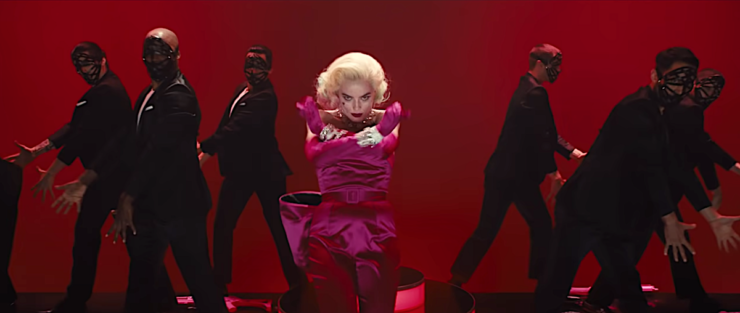One of the many fantastic things about Birds of Prey is the way it gleefully throws different visual languages and references into a movie blender and expects its audience to keep up. Characters and iconography from the DC Universe crash right into a neon ’80s aesthetic. Gotham sometimes seems like a real city, and sometimes seems more like a whimsical, Burton-esque fever dream. But right when we settled in to enjoy a fun rollercoaster of a movie, the film throws two very specific visual cues together and changes its whole tone.
One is common to musicals: the glitzy song-and-dance number that shows the audience a character’s inner life, as in the ballet at the end of An American in Paris, the Buffy episode “Once More with Feeling”, or Elisa’s dance scene in The Shape of Water. The other is common to, well a lot of movies: the moment when a vibrant, charismatic female character is somehow forced into submission by a male character.
These are not chocolate and peanut butter—these tropes do not play well together. And when Birds of Prey combines them the effect is chilling.
But in the midst of all that, there was one tiny, subtle detail that I’ve found myself thinking about for weeks: one of the film’s few nods to realism—Harley Quinn’s split lip. To warn you, this post will be full of spoilers, and physical assault will be discussed.
Birds of Prey’s ad campaign heavily featured a scene of Harley, in full Marilyn/Madonna regalia, singing a breathy take on “Diamonds Are A Girl’s Best Friend.” It seemed like maybe it was a performance, maybe she was singing at Roman Sionis’ club, like Black Canary? Maybe it was an elaborate plot to lull an audience while some of the other Birds of Prey pulled off a heist or a rescue? Maybe this was just Harley’s way to get over a break-up?
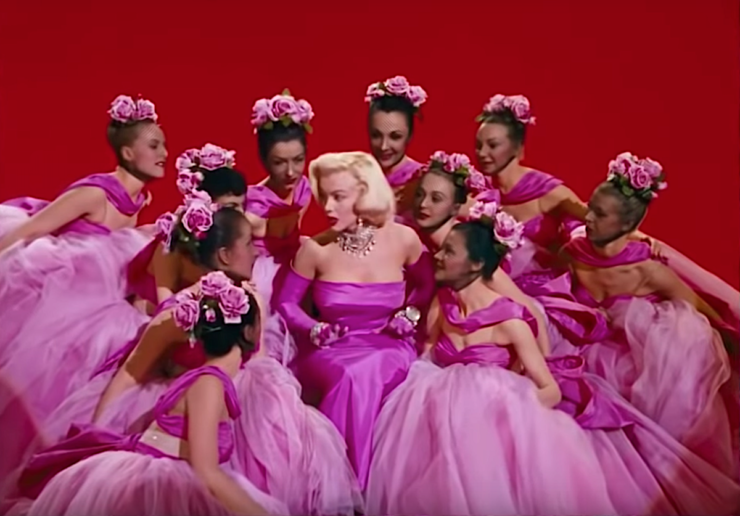
Ordinarily, “Diamonds” is a fun, bubbly song, and jazz/lounge singers perform it with maybe a slight wink. The song was made famous as Lorelei Lee’s credo in the play Gentlemen Prefer Blondes, where it was sung by Carol Channing, and then became iconic when Marilyn Monroe performed it in the 1953 film adaptation. The song gives its female audience straight-ahead advice: in a society that doesn’t allow women equal access to employment and education, the best shot at stability is to look pretty, marry rich, and hoard your jewels.
Each adaptation since has riffed on this original idea. Madonna used the pink dress and an army of boytoys in the “Material Girl” video, which became an ‘80s anthem of excess. Satine sings it in Moulin Rouge because she’s also a woman with limited options, trying to choose between a poor boy she loves, and a rich man who could give her security. When French & Saunders, Christina Aguilera, and Anna Nicole Smith covered it, they were playing off not just the form but the spirit of Monroe’s take. The song is meant to be a little campy, a little cheeky, and somewhat undercut by the other romantic plot of Gentlemen Prefer Blondes, in which Lorelei’s friend, the hard-nosed Jane Russell character, falls for a poor private detective instead of one of the rich men who are pursuing her.
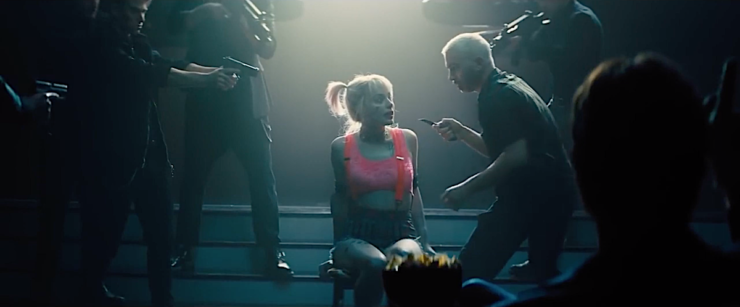
When we get to the song in Birds of Prey, however, it’s treated a little differently. It isn’t a fun, fluffy setpiece. Harley has been captured by Sionis, who knows she isn’t with Mr. J. anymore. She has no protection.
She’s been tied to a chair. How many times have we seen this? When the hero or the damsel is tied up, tortured, taunted? Henry and Indiana Jones, James Bond, Black Widow, John Wick, countless other, less famous examples. This scene is a staple, because this is where you start to feel real fear for the character. They’re helpless, they’ve been caught. They are defenseless. And if the character is a woman? The scene is so often presented as a twisted take on kink, that the person is bound and submissive. Think of Widow asking “Do you really think I’m pretty?” Or, in the male riff, think of Indy being slowly kissed by Ilsa, think of James Bond, Mads Mikkelson, and the open-bottomed chair.
Buy the Book
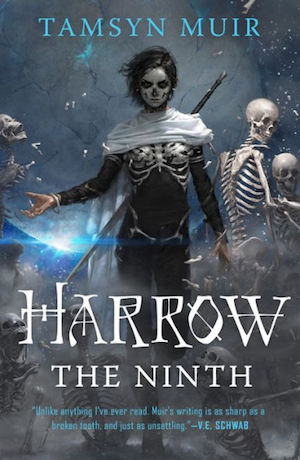

Harrow the Ninth
And now our Harley is here. We’ve watched throughout the movie as she’s pulled one insane stunt after another—beating up guys twice her size, decimating people in roller derby, and even blowing up a chemical factory—and it’s all felt like a cartoon. We haven’t seen her in real physical danger. Because this is Harley, she immediately tries to motormouth her way out of being killed, promising Roman she can get the diamond Cassie Cane stole, and Roman responds the way I was afraid he would: he punches her in the face to shut her up.
This too, we’ve seen, across genre, across era. In To Have and Have Not, Slim snaps at a customs agent and he leans across his desk and slaps her, then explains that he “objected to madame’s tone”; Pretty Woman stops dead to show us Jason Alexander backhanding Vivian for refusing to sleep with him, and allows the scene to drag on and on as she squirms away into the corner of the couch—seemingly helpless despite years of working the streets of L.A.; Titanic gives us a more symbolic riff on this scene when Billy Zane flips the breakfast table over and pins Rose into her chair to scream into her face (because while it would be bad form to allow any of the other First Class passengers to see bruises on his bride-to-be, he needs to make sure she knows what he’s capable of); Avengers introduces Black Widow as she’s backhanded across the face. (And sure, Widow turns the tables on the goons in short order, but her introductory scene in this fun comic book movie, the culmination of four years of MCU groundwork laid by Iron Man, Captain America, and Thor, is a close up shot of the character being struck in the face. Cap is introduced winning a fight with a punching bag, Bruce Banner rushing to what he thinks is a sick child’s bedside, Thor’s entrance is heralded by a lightning storm, Tony Stark flies into Berlin with literal theme music blaring—we meet Widow as she’s being punched in the face.)
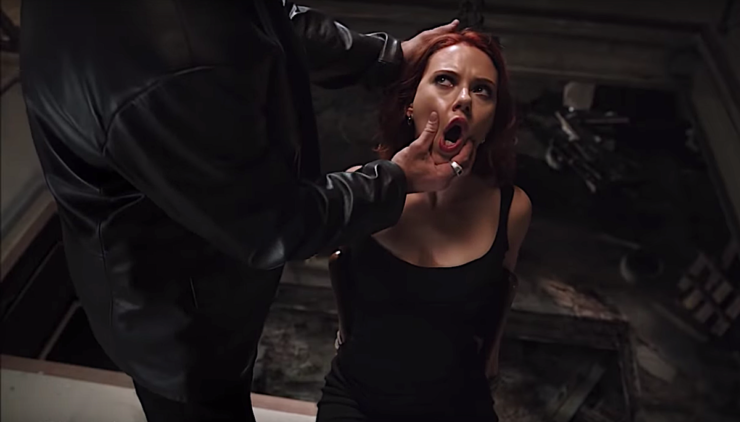
It’s a rare mainstream film that unspools without at least some variant on this moment of a woman being subjugated. In most of the instances, the film glories in a scene later on when the male protagonist avenges the woman.
But when Birds of Prey stages this scene it, as my colleague Christina Orlando said when we left the theater, “hits different.” First, this is the trigger for the fantabulous “Diamonds are a Girl’s Best Friend” number. It’s not a fun performance, or part of a heist—it’s literally Harley escaping into her own mind for a few moments because she’s in pain. Now the bubbly materialist song turns much darker: the diamond is Harley’s best friend because retrieving it is the only way to save her life, and the song about hoarding jewels for financial stability in a world full of unreliable men is about…well, still hoarding jewels, but now it’s the only way to survive in a misogynistic criminal underworld.
We can experience the outrage of seeing these women hit, then experience the catharsis of a man avenging them, or, in Widow’s case, of her turning the tables on them and kicking ass. But we’re never in their heads during this. Either we’re in their male saviors’ heads, or we’re observers.
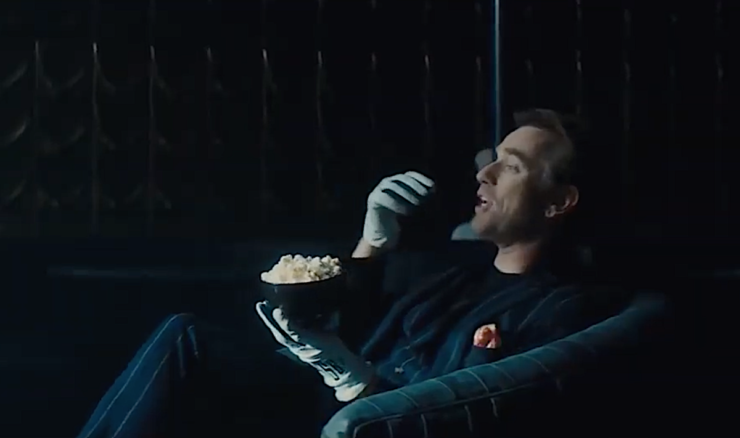
Bird of Prey gives us the version of the Widow scene where there’s actual blood, and real danger, and Cathy Yan and Christina Hodson take us into Harley’s mind to show us how she processes her fear and pain—by returning to a couple of especially femme icons. This is how Harley comforts herself.
But it’s what comes after the song that really got to me.
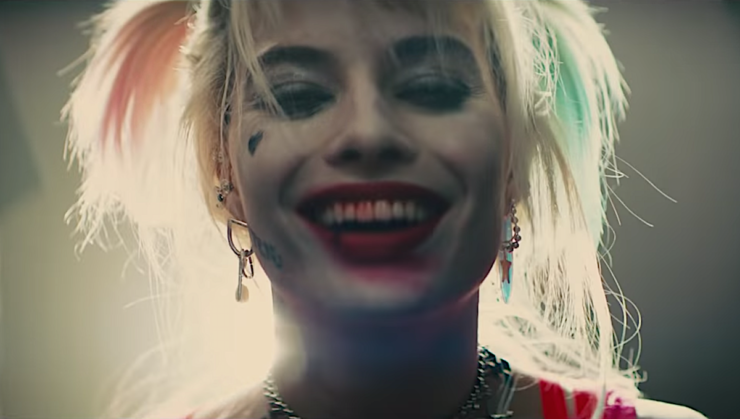
When Roman punches Harley, we see that her lip is split and bleeding. She has blood on her teeth. Every time we see her face after this her lip is still split, whether covered with lipstick or tequila or grease from the perfect breakfast sandwich. The consequences of the punch are front and center. Compare with Slim, Vivian, and Widow—Widow especially.
We get an extravagant close up of Widow being punched, and when she glares back at the man who hit her, her lipstick isn’t even smudged. She’s flawless—no blood, no bruise, no headache, no jaw pain. Just a brief headshake like a dog climbing out of a pool. How many times have we seen superheroes punched with no consequences? Actually, when do you see superheroes hurt with consequences for more than a scene or two?
Bruce Wayne is actually injured by Bane in The Dark Knight Rises—but then he uses Magical Spine-Healing Rope and he’s back in business. Who else? Everyone in Logan, I suppose—but the ravages of age and death are kind of the point of the film. Of the more “fun” superhero movies, Netflix’s version of Daredevil is the only one I can think of lately who gets hurt. We watch Matt Murdock get seriously injured, we watch him heal, we watch wounds reopen. But here, too, it’s somewhat built into the show’s Catholic martyr imagery, and he uses Magical Healing Meditation to speed the process up. Doctor Strange’s origin story centers on trauma and pain, but, again, the pain is only centered before he becomes a superhero; it fades into the background after his confrontation with Dormammu.
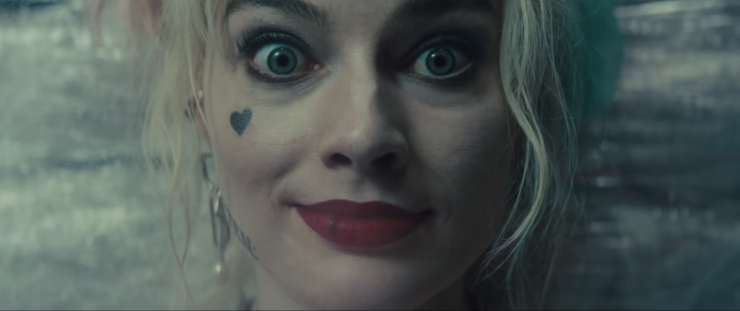
In Bird of Prey Harley’s split lip is front and center, a constant silent acknowledgement of Roman’s attempt to dehumanize her, an underline on the idea that her body has been acted upon. There isn’t enough time for her wound to heal, so rather than covering it up the filmmakers made sure to add it to Robbie’s lip in every single scene, to allow a flaw in their heroine’s face, to show how dried blood fucks up a line of lipstick, to show us, in this tiny way, that violence always has a consequence.
Leah Schnelbach wants a BoP sequel with Poison Ivy almost as much as she wants healthcare workers to have their student loans erased. Come discuss diamonds with them on Twitter!










